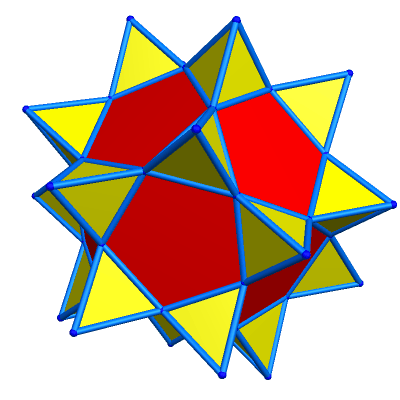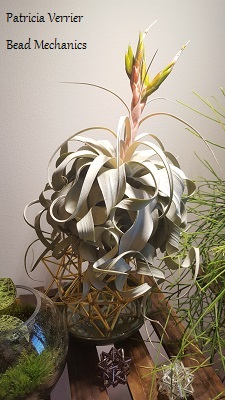I made this airplant stand last year. It’s based on an icosidodecahedron, and is both partially augmented and partially excavated.

Augmentation means that you add another shape to each face – in this case it’s a tetrahedron on each triangle face. Since an icosidodecahedron has both triangle and pentagon faces, this means only some of the faces have been augmented, so it’s a partial augmentation.
Excavation means sort of the opposite – where you would join five triangles to make a dome or pyramid over a pentagon face to augment it, excavation is the reverse – the dome or pyramid points down into the centre of the polyhedron, making a bowl-like depression. Because this is only done to the pentagon faces again it’s a partial excavation.
The combination of the two gives and interesting combination of peaks and valleys that I really like, and also makes it an excellent air plant stand! The shape itself is just made by using a modified form of right-angle weave to place the bugles over each edge of the polyhedron.
I used 30mm bugles meaning the finished piece is quite large, so it became home to a Tillandsia Xerographica, one of the bigger airplants! Here it is back when I finished it last summer:
And here it is now – the airplant has a beautiful flower spike on it at the moment so is clearly happy with the stand!
The flowers are really interesting – most of the spike is the flower bract, while the flowers themselves are quite small with tightly closed pale pink petals:
This isn’t my first attempt at combining plants and beads either – I’ve made a few smaller airplant stands from bugle beads too, although they don’t currently have any airplants in them.
They’re only suitable for very small plants, and the ones that were in them have outgrown them. They’d probably be better if they were the other way up, although I’d need to take care to find airplants that are happy growing upside down if I did that.
Still a bit of a work in progress, but a fun series of experiments!
The animations of the icosidodecahedron shown in this post were created with Stella4D Pro.





